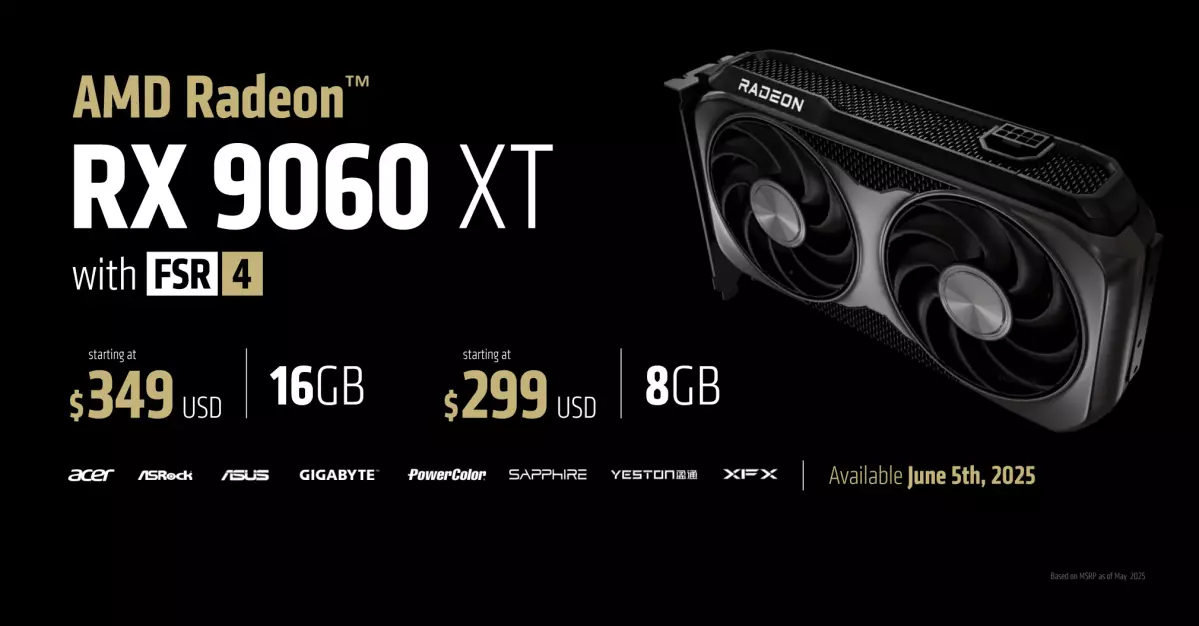The ever-shifting terrain of the graphics processing unit (GPU) market is witnessing an exciting chapter with the advent of AMD’s recent announcement regarding the Radeon RX 9060 XT. Set against the backdrop of Computex, AMD’s unveiling signifies a strategic maneuver to contend with Nvidia’s newly rolled out RTX 5060 and 5060 Ti. As consumers become more discerning, the implications of this rivalry are monumental not just for tech enthusiasts but for budget-conscious gamers longing for top-tier performance. While AMD has yet to disclose an official price for the RX 9060 XT, the competitive edge will stem from its specifications and how it maneuvers through the challenges set by Nvidia’s pricing and approach.
A Shift in VRAM Strategy
One of the most contentious issues in the current GPU landscape is the amount of video memory (VRAM). Both AMD and Nvidia have opted to launch their flagship GPUs with only 8GB of VRAM, igniting a heated debate among gamers and reviewers alike. Despite the advancements in gaming technology and the increasing appetite for higher resolutions and more detailed textures, these manufacturers seem reluctant to deliver on memory. AMD is charging forward with its RX 9060 XT and an option to upgrade to 16GB of VRAM for a slightly higher price, however, this dual approach raises questions: Can even 16GB sustain demanding future titles? With modern games continuously pushing the limits, this underwhelming memory capacity appears to challenge the industry’s commitment to quality gaming experiences.
Performance Potential and Benchmark Concerns
AMD asserts that its 16GB RX 9060 XT is approximately 6% faster than Nvidia’s RTX 5060 Ti when measured at 1440p resolution based on its internal tests. This statistic is fascinating on the surface but needs further scrutiny. The credibility of performance benchmarks lies not just in the numbers provided by the manufacturer but also in real-world applications and independent validations. Thus far, Nvidia’s peculiar decision to launch their RTX 5060 without extensive third-party reviews leaves a suspicious vacuum that could influence the market dynamics.
Nvidia’s recent marketing strategies have sparked discourse regarding their transparency, particularly concerning the Multi Frame Generation (MFG) feature; a technology that, if presented effectively, could curtail the impact of limited VRAM. Criticism has arisen as the Gamers Nexus YouTube channel reported on Nvidia’s attempts to dictate how certain technologies are discussed, raising ethical considerations about transparency in benchmarking practices.
The Future of Gaming Graphics
With both companies poised in a battle for dominance, the implications of their strategies extend beyond raw specs. AMD and Nvidia must confront a rapidly evolving gaming landscape where consumer expectations pivot toward higher performance and value for investment. Utilizing 32 RDNA 4 compute units and a boost clock of 3.13GHz, the RX 9060 XT is designed to deliver impressive performance; however, AMD must judiciously handle the narrative around VRAM to mitigate potential backlash from an increasingly educated and vocal gaming community.
As technology burgeons and gaming demands evolve, the dialogue about what constitutes best value is crucial. Consumers who are hungry for powerful graphics must weigh immediate performance against the long-term viability of their investments. Can AMD’s hesitant commitment to VRAM expansion hit the sweet spot, or will users find themselves left wanting in a year or two when the next gaming revolution unfolds?
A Call for Consumer Empowerment
Above all, the current climate underlines the importance of consumer awareness and empowerment in the tech landscape. The power lies not solely with manufacturers to dictate trends but with the informed user who scrutinizes claims and holds companies accountable for their products. Given the uproar over limited VRAM and Nvidia’s somewhat opaque practices, consumers must rally behind transparency and advocate for products that truly meet their gaming needs. The RX 9060 XT may represent a forward step for AMD, but the real victory will belong to those who demand not just performance, but also innovation and respect in a fiercely competitive market.

